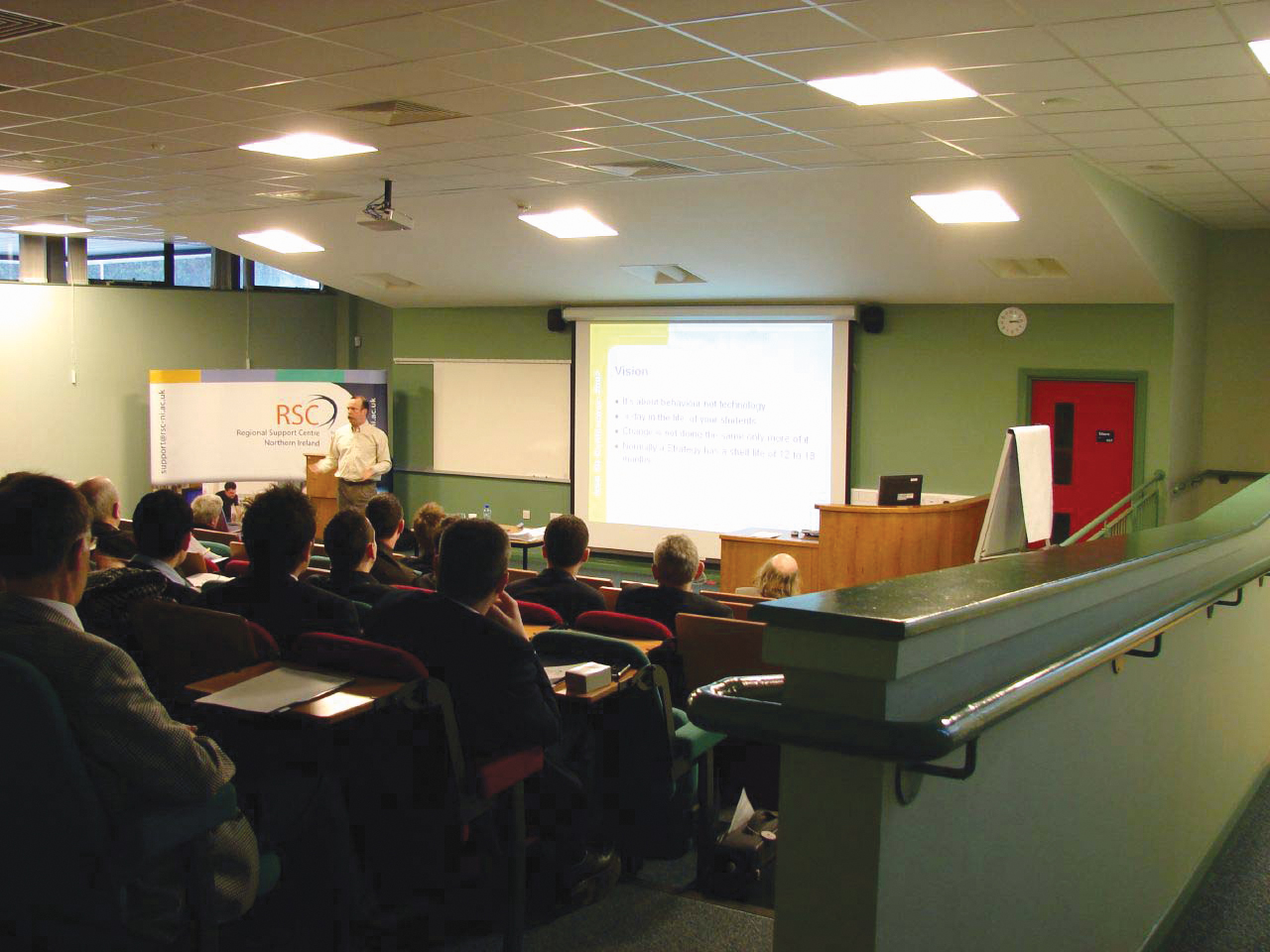
Picture: JISC InfoNet
RSS324 US Department of Transportation (USDOT) views ITS as key to the future of transportation, as is evident from the department’s ITS Professional Capacity Building (PCB) program. This is a further manifestation of USDOT’s commitment to ITS. The PCB program provides anyone in the transportation industry with a variety of methods to learn more about ITS. Maybe the best part about the program is that virtually all of the resources are free – a service of the US government.
The intention from USDOT is to aid public agencies’ in ‘building and sustaining a capable and technically proficient ITS workforce, and to support transportation professionals in developing their knowledge, skills and abilities while furthering their career paths’.
“Efficient deployment of ITS technologies requires an educated workforce,” explains Mac Lister, program manager for knowledge and technology transfer at RITA (Research & Innovative Technology Administration, ITS Joint Program Office, USDOT). “We aim to develop the workforce capacity across the entire ITS industry, beginning with attracting future ITS professionals, providing continuous learning to practitioners at public and private sector organisations, and informing decision makers of the benefits of the technologies.”
The PCB is funded by RITA's ITS Joint Program Office and supported by560 ITS America, the American Association of State Highway and Transportation Officials (AASHTO), the 5667 Institute of Transportation Engineers (ITE), the 5668 National Transportation Operations Coalition (NTOC), the 856 Transportation Research Board (TRB) and others. The program targets a broad audience working in ITS including federal, state and regional transportation employees, as well as private sector contractors and consultants. These ITS practitioners include engineers, managers, planners and a variety of other specialists involved with all surface transportation modes: transit, motor carriers, highways/roadways and rail.
As ITS technology continues to evolve and become more mainstream, an even broader community of transportation workers is requiring professional development in ITS. “Today's audience for the ITS PCB is a very diverse group of people, across electrical engineering, computer engineering, software, telematics, communications, civil engineering and transportation engineering,” says ITE’s senior director for transportation technology Siva Narla, who is also ITE's program manager for the ITS PCB standards training program. “For example, consider a telematics engineer, auto manufacturer or software developer – they generally do not have the domain knowledge in ITS. This training helps them bridge the gap.”
In the ITS PCB Strategic Plan, published in 2010, USDOT notes that the ITS user community faces a number of workforce challenges for the coming years, such as an ageing workforce and baby boomer retirements; the need to attract and retain a younger and increasingly more diverse workforce; and a need to educate the workforce about emerging technologies often involving multiple disciplines.
“We do not have enough ITS experts with the domain knowledge. We need to attract people from various IT domains because this is becoming a multi-disciplinary field,” Narla adds. “The ITS PCB training modules and resources help those individuals get familiarised with the domain. This is a field that is growing by leaps and bounds. We need those people desperately.”
The ITS PCB program was authorised by US Congress in 1996 to develop the workforce competencies necessary to transform the transportation infrastructure through ITS.
The program is driven by the idea that fast and successful adoption of new technologies depend on a workforce that is aware of new technologies and research results; knowledgeable about procurement and specifications; skilled in incorporating new technologies into existing systems; trained to oversee the implementation process from a systems perspective; and capable of putting ITS technologies into use. The ITS PCB program aims to support each of these capabilities in today's transportation professional.
“The program started off by providing classroom-based training, but soon began placing the majority of its materials into electronic format for e-learning to allow workers to attend training from the comfort of their own offices without incurring travel costs,” Lister explains. “Today, most of our training is conducted through online classes or webinars. We have introduced some blended learning to provide an opportunity to interact with the instructor and other students via conference call or chat room.”
“As we prepare our 21st century workforce to adopt new connected vehicle technologies and implement proven ITS solutions, we must take advantage of 21st Century tools for digital learning,” he continues. “This includes the use of social media, videos, and hands-on tools such as interactive games and simulation.”
The ITS PCB program focuses on four types of content: emerging technologies such as vehicle-to-vehicle (V2V) and vehicle-to-infrastructure (V2I) communications; current ITS JPO research initiatives such as Integrated Corridor Management (ICM) and Mobility Services for All Americans (MSAA); existing ITS technologies with proven benefits; and foundational topics such as ITS architecture and standards.
For example, the program offers a series of 90-minute web-based modules providing training on ITS standards. The first set of modules currently available includes topics such as ITS standards testing and technologies such as Dynamic Message Signs and Environmental Sensor Systems based on NTCIP and TMDD standards. The 18-module series is designed to be viewed in order, starting with the first module: ‘Using ITS standards: an overview’. The series is aimed at practitioners in state and local highway and transit agencies seeking skills to procure, implement and operate ITS standards-based devices and equipment. USDOT notes that consultants and systems designers, integrators, and testers will also find the training valuable.
The ITS PCB program also offers a series of Talking Technology & Transportation (T3) webinars on a variety of ITS topics, all available on-demand online. T3 webinars cover a wide range of content related to ITS planning, design, procurement, deployment and operations. The webinars focus on mode-specific or intermodal topics; ITS devices such as dynamic message signs and traffic signals; ITS applications such as road weather information systems; and cross-cutting concerns such as systems engineering, ITS architecture, standards and wireless communications. During these interactive online meetings, experts from academia, research and private industry, as well as front line ITS implementers from public-sector highway and transit agencies, deliver 60 minute presentations followed by 30 minutes of Q&A.
“We conduct in-person training when hands-on experience or an instructor’s presence is determined to be the most effective way to provide learning,” Lister adds. “We offer opportunities for in-person collaboration with an ITS expert through our Peer-to-Peer program, making sure to capture this experience in webinar format for distribution to a wider audience.”
The ITS Peer-to-Peer (P2P) program provides short-term technical assistance to specific transportation agencies facing ITS planning, procurement, deployment and operational challenges. Other courses, both online and in the classroom, cover topics such as congestion management, traffic incident management, high-occupancy tolling, commercial vehicle information systems and networks, and advanced transportation management systems.
Although the ITS PCB program does not offer professional development hours (PDH) through the USDOT, completion of some program courses qualify for PDH with specific licensing agencies.
USDOT is moving forward on two initiatives to expand the program in 2012. The first is developing a second set of modules for ITS standards training. Topics for the new modules are expected to include communications protocols, Simple Network Management Protocol (SNMP), traffic sensor systems, actuated traffic signal controllers, electrical and lighting management and CCTV systems, freeway management centers, open advanced transportation control systems and more.
Pilot programs will be ran this year during the development phase, and the modules are expected to be completed and available to the industry by mid-2013. ITE is responsible for the development of these modules, and Siva Narla notes that there is potential for a third set of modules in the future.
The second new project is the development of an ePrimer for ITS, along with a video library for ITS best practices. The ePrimer, also in development by ITE and expected to be available by the end of next year, will serve as a digital web-based interactive replacement for the current hard copy ITS primer available from USDOT. The ePrimer will document ITS terminology and explain ITS systems and subsystems.
USDOT is currently looking for new ways to deliver ITS-related content to the industry, especially to students, and is reaching out to university partners to figure out how they can offer resources to incorporate ITS concepts and training into academic coursework.
“The ITS PCB program is extremely important and we need to make people aware that these programs exist and how exciting they are,” says ITS America CTO Nu Rosenbohm. “The USDOT is very wisely looking to the future as it provides this outreach to the student community.”
Siva Narla adds: “The standards training modules, the ePrimer and all ITS PCB materials are all openly available resources to ITS practitioners across the US and around the world. Users do not have to be a member of ITE, AASHTO or NEMA to utilise the program. People from all over the globe can take advantage of these standards and training.”
ITS PCB courses are available by registering through the program's website: www.its.pcb.com.RSS
A substantial portfolio of resources is available and expanding, to help employers and professionals build essential skills for current and future needs – the ITS Professional Capacity Building Program. Pete Goldin reports.
TheThe intention from USDOT is to aid public agencies’ in ‘building and sustaining a capable and technically proficient ITS workforce, and to support transportation professionals in developing their knowledge, skills and abilities while furthering their career paths’.
“Efficient deployment of ITS technologies requires an educated workforce,” explains Mac Lister, program manager for knowledge and technology transfer at RITA (Research & Innovative Technology Administration, ITS Joint Program Office, USDOT). “We aim to develop the workforce capacity across the entire ITS industry, beginning with attracting future ITS professionals, providing continuous learning to practitioners at public and private sector organisations, and informing decision makers of the benefits of the technologies.”
The PCB is funded by RITA's ITS Joint Program Office and supported by
As ITS technology continues to evolve and become more mainstream, an even broader community of transportation workers is requiring professional development in ITS. “Today's audience for the ITS PCB is a very diverse group of people, across electrical engineering, computer engineering, software, telematics, communications, civil engineering and transportation engineering,” says ITE’s senior director for transportation technology Siva Narla, who is also ITE's program manager for the ITS PCB standards training program. “For example, consider a telematics engineer, auto manufacturer or software developer – they generally do not have the domain knowledge in ITS. This training helps them bridge the gap.”
In the ITS PCB Strategic Plan, published in 2010, USDOT notes that the ITS user community faces a number of workforce challenges for the coming years, such as an ageing workforce and baby boomer retirements; the need to attract and retain a younger and increasingly more diverse workforce; and a need to educate the workforce about emerging technologies often involving multiple disciplines.
“We do not have enough ITS experts with the domain knowledge. We need to attract people from various IT domains because this is becoming a multi-disciplinary field,” Narla adds. “The ITS PCB training modules and resources help those individuals get familiarised with the domain. This is a field that is growing by leaps and bounds. We need those people desperately.”
21st Century learning
The ITS PCB program was authorised by US Congress in 1996 to develop the workforce competencies necessary to transform the transportation infrastructure through ITS.
The program is driven by the idea that fast and successful adoption of new technologies depend on a workforce that is aware of new technologies and research results; knowledgeable about procurement and specifications; skilled in incorporating new technologies into existing systems; trained to oversee the implementation process from a systems perspective; and capable of putting ITS technologies into use. The ITS PCB program aims to support each of these capabilities in today's transportation professional.
“The program started off by providing classroom-based training, but soon began placing the majority of its materials into electronic format for e-learning to allow workers to attend training from the comfort of their own offices without incurring travel costs,” Lister explains. “Today, most of our training is conducted through online classes or webinars. We have introduced some blended learning to provide an opportunity to interact with the instructor and other students via conference call or chat room.”
“As we prepare our 21st century workforce to adopt new connected vehicle technologies and implement proven ITS solutions, we must take advantage of 21st Century tools for digital learning,” he continues. “This includes the use of social media, videos, and hands-on tools such as interactive games and simulation.”
The ITS PCB program focuses on four types of content: emerging technologies such as vehicle-to-vehicle (V2V) and vehicle-to-infrastructure (V2I) communications; current ITS JPO research initiatives such as Integrated Corridor Management (ICM) and Mobility Services for All Americans (MSAA); existing ITS technologies with proven benefits; and foundational topics such as ITS architecture and standards.
For example, the program offers a series of 90-minute web-based modules providing training on ITS standards. The first set of modules currently available includes topics such as ITS standards testing and technologies such as Dynamic Message Signs and Environmental Sensor Systems based on NTCIP and TMDD standards. The 18-module series is designed to be viewed in order, starting with the first module: ‘Using ITS standards: an overview’. The series is aimed at practitioners in state and local highway and transit agencies seeking skills to procure, implement and operate ITS standards-based devices and equipment. USDOT notes that consultants and systems designers, integrators, and testers will also find the training valuable.
The ITS PCB program also offers a series of Talking Technology & Transportation (T3) webinars on a variety of ITS topics, all available on-demand online. T3 webinars cover a wide range of content related to ITS planning, design, procurement, deployment and operations. The webinars focus on mode-specific or intermodal topics; ITS devices such as dynamic message signs and traffic signals; ITS applications such as road weather information systems; and cross-cutting concerns such as systems engineering, ITS architecture, standards and wireless communications. During these interactive online meetings, experts from academia, research and private industry, as well as front line ITS implementers from public-sector highway and transit agencies, deliver 60 minute presentations followed by 30 minutes of Q&A.
“We conduct in-person training when hands-on experience or an instructor’s presence is determined to be the most effective way to provide learning,” Lister adds. “We offer opportunities for in-person collaboration with an ITS expert through our Peer-to-Peer program, making sure to capture this experience in webinar format for distribution to a wider audience.”
The ITS Peer-to-Peer (P2P) program provides short-term technical assistance to specific transportation agencies facing ITS planning, procurement, deployment and operational challenges. Other courses, both online and in the classroom, cover topics such as congestion management, traffic incident management, high-occupancy tolling, commercial vehicle information systems and networks, and advanced transportation management systems.
Although the ITS PCB program does not offer professional development hours (PDH) through the USDOT, completion of some program courses qualify for PDH with specific licensing agencies.
Expanding the classroom
USDOT is moving forward on two initiatives to expand the program in 2012. The first is developing a second set of modules for ITS standards training. Topics for the new modules are expected to include communications protocols, Simple Network Management Protocol (SNMP), traffic sensor systems, actuated traffic signal controllers, electrical and lighting management and CCTV systems, freeway management centers, open advanced transportation control systems and more.
Pilot programs will be ran this year during the development phase, and the modules are expected to be completed and available to the industry by mid-2013. ITE is responsible for the development of these modules, and Siva Narla notes that there is potential for a third set of modules in the future.
The second new project is the development of an ePrimer for ITS, along with a video library for ITS best practices. The ePrimer, also in development by ITE and expected to be available by the end of next year, will serve as a digital web-based interactive replacement for the current hard copy ITS primer available from USDOT. The ePrimer will document ITS terminology and explain ITS systems and subsystems.
USDOT is currently looking for new ways to deliver ITS-related content to the industry, especially to students, and is reaching out to university partners to figure out how they can offer resources to incorporate ITS concepts and training into academic coursework.
“The ITS PCB program is extremely important and we need to make people aware that these programs exist and how exciting they are,” says ITS America CTO Nu Rosenbohm. “The USDOT is very wisely looking to the future as it provides this outreach to the student community.”
Siva Narla adds: “The standards training modules, the ePrimer and all ITS PCB materials are all openly available resources to ITS practitioners across the US and around the world. Users do not have to be a member of ITE, AASHTO or NEMA to utilise the program. People from all over the globe can take advantage of these standards and training.”
ITS PCB courses are available by registering through the program's website: www.its.pcb.com.RSS












